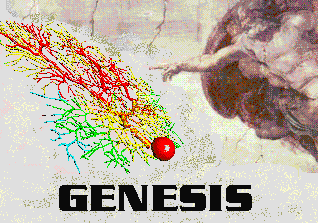

The main page http://genesis-sim.org provides links to documentation and tutorials for the GENESIS 3 (G-3) project. This is intended to be a 21st century neural simulator without the limitations of GENESIS 2 and other simulators that were developed in the late 1980's and 90's. Presently, G-3 remains in the development stage and its future is uncertain. However, the G-3 documentation contains some rather general tutorials on creating GENESIS GUIs with Python.
The November 2014 release of GENESIS 2.4 was intended to be the last packaged GENESIS 2 distribution for download from the GENESIS web site. Updates to GENESIS and PGENESIS are now obtained from the Repository for Continued Development of the GENESIS 2.4 Neural Simulator ( https://github.com/genesis-sim/genesis-2.4).
Although GENESIS 2 is user-suported, rather than being being actively developed, users continue to contribute new libraries, documentation, and simulation scripts. GENESIS continues to be widely used for large network models consisting of multicompartmental neurons, and for projects in modeling courses. In particular, there has been an increased use and extension of GENESIS and PGENESIS for its original purpose of realistically modeling cortical networks on parallel computers.
What was intended to be a final release of the GENESIS 2 series has continued to evolve, with modifications needed to efficiently implement synaptic plasticity in large networks and with many contributions from users. This has made it necessary for a new combined May 2019 GENESIS 2.4 Update and the PGENESIS 2.4 Final Release.
Although the version number has not changed, recent user-contributed updates are significant enough to warrant this new combined packaged distribution. The official release of PGENESIS 2.4 is much improved from the December 2014 preliminary release. Recent updates to GENESIS and a merge of the GENESIS/PGENESIS development branch from the U.S. Army Research Laboratory have addressed a number of issues that limited its scalability for modeling very large networks on high performance computing resources. Optional installation of a garbage collector library drastically reduces memory usage, allowing for models of millions of neurons. Various run-time errors and integer overflow issues were eliminated. Changes in PGENESIS insured the repeatability of random connections between simulation runs. Updates of GENESIS since the 2014 release allow the fast "hsolve" solver to be used with new synaptic plasticity models and electric field measurements. The efficient delivery of spike events when hsolve is used with large network models results in increases in simulation speed by factors of 10 to 20.
This official release of PGENESIS 2.4 is now available for running large-scale network simulations on supercomputers at the Neuroscience Gateway Portal (NSG). For further information, see the https://www.nsgportal.org web page.
The Sourceforge genesis-sim-users mailing list is the best means of obtaining help with GENESIS. You may subscribe at https://lists.sourceforge.net/lists/listinfo/genesis-sim-users. Questions posted to the genesis-sim-users mailing list usually receive a prompt response.
Further updates to GENESIS and PGENESIS 2.4 continue to be made and can be found at the Repository for the continued development of the GENESIS 2.4 neural simulator at https://github.com/genesis-sim/genesis-2.4
Updates to the original GENESIS 2.4 release include:
The original GENESIS 2.4 release includes:
Some recently added GENESIS 2 tutorials and simulations
Ultimate GENESIS Tutorial Distribution
This is a complete self-paced GENESIS modeling course, combined with GENESIS binary and source distributions and installation instructions. It provides an easy way to get everything by downloading a single package. The latest version may be browsed from this link.
This latest version was used as course materials for the tutorial Constructing biologically realistic neuron and network models with GENESIS at CNS 2014 presented by Hugo Cornelis.
You can download it as:
UGTD2-CNS.tar.gz or UGTD2-CNS.zip
VAnet2 - An efficient hsolved GENESIS version of the Vogels and Abbott (2005) model that was used in the Brette et al. (2007) review of network simulators. It serves as a tutorial on the use of hsolve with network models in order to achieve speedups by a factor of 10 to 20. The 'VAnet2-batch.g' script is intended to be extended for testing GENESIS spike timing dependent plasticity (STDP) implementations with hsolve. This script would be a good starting point for models that use more realistic cells and connections.
ACnet2 - An auditory cortex model that also serves as a tutorial and template for creating neocortical network models.
fMRInet Is a variation of the ACnet2 model that illusrates how to provide unusual stimuli, such as the effects of the electromagnetic fields that are produced during an fMRI experiment. This is done by using a 'script_out' object to provide the stimulus at clocked intervals.
The GENESIS web site was established June 30, 1994.